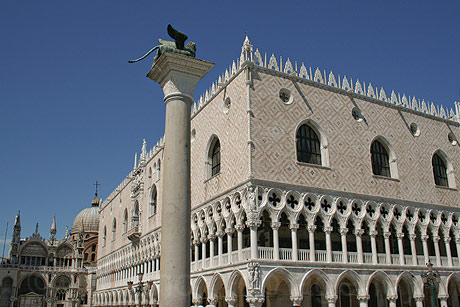Doge's Palace

The Doge’s Palace is, by far, one of the densest tourist sights in Venice. At the same time, it is iconic for both the historical background and the cultural caliber of the city, one of the must-visits which would otherwise render a stay in Venice incomplete. This historical edifice is managed by MUVE and, thus, preserved as a museum.
Located in the monumental Piazza San Marco, the Doge’s Palace dates back to the 9th century, though much of its present structure was largely built between 1309 and 1424, the paternity of its design being attributed to Filippo Calendario. Understandably for a building of this age, the palace underwent sundry modifications and additions, such as the so-called Porta della Carta, added in 1442 by Giovanni and Bartolomeo Bon. Until the mid 15th century, the palace kept its original sober Gothic dash, but neo-classical influences started to take over, at least in part, as from the 16th century, after a major fire which affected most of the palace made it necessary for the authorities to restore the structure. Andrea Palladio was the chief architect in charge with this task, and it is to him that the deviations from the pure original Gothic guidelines are owed. However, the bottom line is, by force of the successive structural accumulations, the monumental Palazzo Ducale became in time one of the largest and most impeccable architectural structures in Italy.
The palace used to serve as residence of the doges, that is, of the dukes of Venice, supreme rulers of the Republic of Venice to whom the city owes much of its historical prominence, prestige and achievements. A very interesting historical reference to the Doge’s Palace is Giacomo Casanova himself was imprisoned in one of the cells of the palace, from where, in fact, he eventually escaped.
The inner splendor of the palace does not fall short of its outer magnificence. Thus, on the outside, the facade strikes by its robust arcades which, despite the massiveness of the building, give the impression the entire structure floats. On the inside, highlights like Sala del Maggior Consiglio (the Grand Council Chamber), the so-called Scala d’Oro (the Golden Staicase), Le Prigioni, meaning the Prison Cells (divided, according to their location, in Pozzi and Piombi, from where Casanova escaped), L’Appartamento Ducale (the Doge’s Apartments) and Il Museo dell’Opera (the Opera Museum), which is located on the first floor of the palace, as well as L’Armeria (the Armory) should not be missed out.
In order to make sure all of these highlights and plenty others (such as the paintings by Tintoretto and Paolo Veronese) will not be overlooked, the best way to plan a visit to Palazzo Ducale is to resort to the guided tours offered by the personnel (for instance, the so-called Il Concorso per il Paradiso della Sala del Maggior Consiglio and Paolo Veronese in Palazzo Ducale). Gli Itinerari Secreti (the Secret Itinerary) is available only on request and by reservation, and only provided that the public complies with certain requirements.
Unsurprisingly, holding a Museum Pass is the most-cost efficient way of visiting the Doge’s Palace.
- Name:
- Doge’s Palace (Palazzo Ducale)
- Address:
- 1, San Marco, 30124, Venice, Italy
- Telephone:
- 0039 041 2715911
- Fax:
- 0039 041 5285028
- Email:
- [email protected]
- Website:
- www.museiciviciveneziani.it
- Opening hours:
- 1st April to 31st October: 8:30am to 7pm; 1st November to 31st March: 8:30am to 5:30pm
 Side View of the Doge's Palace in Venice
Side View of the Doge's Palace in Venice